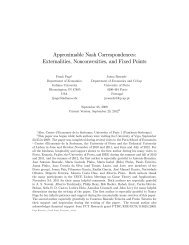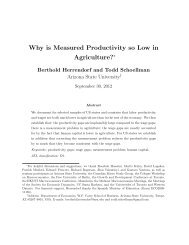Estimation and Inference of Discontinuity in Density
Estimation and Inference of Discontinuity in Density
Estimation and Inference of Discontinuity in Density
Create successful ePaper yourself
Turn your PDF publications into a flip-book with our unique Google optimized e-Paper software.
size at the values <strong>of</strong> enrollments that are just above multiples <strong>of</strong> 40, e.g., 41-45, 81-85, etc. Angrist<strong>and</strong> Lavy (1999) used this rule as an exogenous source <strong>of</strong> variation <strong>in</strong> class size to identify the e¤ects<strong>of</strong> class size on the scholastic achievement <strong>of</strong> Israeli pupils.An important identify<strong>in</strong>g assumption <strong>of</strong> Angrist <strong>and</strong> Lavy (1999) is no manipulation <strong>of</strong> class size byparents, which is the test<strong>in</strong>g focus <strong>of</strong> this section. Precisely, there could be two k<strong>in</strong>ds <strong>of</strong> manipulation.The …rst one is that parents may selectively exploit the Maimonides’rule by register<strong>in</strong>g their children <strong>in</strong>the schools with enrollments just above multiples <strong>of</strong> 40 so that their children are placed <strong>in</strong> classes withsmaller sizes. Follow<strong>in</strong>g McCrary’s (2008) arguments, this would lead to an <strong>in</strong>crease <strong>in</strong> the density <strong>of</strong>enrollment counts around the po<strong>in</strong>t that is just above a multiple <strong>of</strong> 40. Angrist <strong>and</strong> Lavy (1999) arguedthat this k<strong>in</strong>d <strong>of</strong> manipulation is unlikely to happen for two reasons. First, Israeli pupils are requiredto attend school <strong>in</strong> their local registration area. Also, pr<strong>in</strong>cipals are required to grant enrollment tostudents with<strong>in</strong> their district <strong>and</strong> are not permitted to register students from outside their district.Second, even <strong>in</strong> exceptional cases that parents <strong>in</strong>tentionally move to another school district hop<strong>in</strong>g toget a better draw <strong>in</strong> the enrollment lottery (e.g. 41-45 <strong>in</strong>stead <strong>of</strong> 38), “there is no way to know (exactly)whether a predicted enrollment <strong>of</strong> 41 will not decl<strong>in</strong>e to 38 by the time school starts, obviat<strong>in</strong>g the needfor two small classes”(Angrist <strong>and</strong> Lavy, 1999).The second k<strong>in</strong>d <strong>of</strong> manipulation <strong>of</strong> class size is that parents may extract their kids from the publicschool system when they …nd the enrollments <strong>of</strong> the schools where their kids are registered are justbelow multiples <strong>of</strong> 40. This would lead to a decrease <strong>of</strong> the enrollment density on the left side <strong>of</strong> themultiples <strong>of</strong> 40. However, as argued by Angrist <strong>and</strong> Lavy, unlike <strong>in</strong> the United States private elementaryschool<strong>in</strong>g is rare <strong>in</strong> Israel.To assess the validity <strong>of</strong> the assumption <strong>of</strong> no manipulation <strong>of</strong> class size we test cont<strong>in</strong>uity <strong>of</strong> thedensity function <strong>of</strong> enrollment counts. We consider …fth graders. In the end, our data conta<strong>in</strong>ed 2029schools (Angrist <strong>and</strong> Lavy, 1999). The histogram is displayed <strong>in</strong> Figure 2. It shows a sharp <strong>in</strong>crease <strong>of</strong>densities at the enrollment <strong>of</strong> 40 but such <strong>in</strong>crease is not clearly observed for other multiples <strong>of</strong> 40. Thisobservation is re<strong>in</strong>forced <strong>in</strong> graphical analysis displayed <strong>in</strong> Figures 3 <strong>and</strong> 4, which show the estimatedenrollment density function us<strong>in</strong>g the data on the either side <strong>of</strong> 40 <strong>and</strong> 120 respectively.We perform the b<strong>in</strong>n<strong>in</strong>g <strong>and</strong> local likelihood estimation (^ G <strong>and</strong> ^) <strong>and</strong> the associated tests (W G ,`G, <strong>and</strong> `) <strong>of</strong> the discont<strong>in</strong>uities <strong>in</strong> enrollment densities that are suspected at the multiples <strong>of</strong> 40 overa range <strong>of</strong> smooth<strong>in</strong>g b<strong>and</strong>widths. The results are summarized <strong>in</strong> Table 4.The local likelihood method …nds upward jumps <strong>of</strong> the enrollment density at c =40, 80, <strong>and</strong> 120<strong>and</strong> a downward jump at c = 160. The associated empirical likelihood tests show that the discont<strong>in</strong>uityat an enrollment <strong>of</strong> 40 is very signi…cant with test statistics all valued larger than 20 for di¤erentb<strong>and</strong>widths. The evidence <strong>of</strong> discont<strong>in</strong>uity at 80 is relatively weak <strong>and</strong> signi…cance depends on theb<strong>and</strong>width used, while no evidence <strong>of</strong> discont<strong>in</strong>uity is found at 120 <strong>and</strong> 160. The progressively weakerevidence <strong>of</strong> discont<strong>in</strong>uity co<strong>in</strong>cides with the extent <strong>of</strong> decrement <strong>of</strong> class sizes at di¤erent multiples <strong>of</strong>40. For example, accord<strong>in</strong>g to Maimonides’rule, the class size drops faster at the enrollment <strong>of</strong> 40 than13






